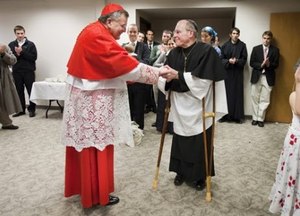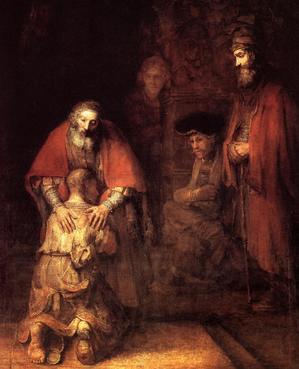In the NY Times yesterday the editors published a few paragraphs on Bill Keller and his coverage of Catholicism for the 8 last years. It was really a screed on being the priests of truth. However, the article indicates that he has gratitude for his Catholic education, noting his the fervent faith of his parents, especially his mother. But the rub for me is that now Keller identifies himself as a “collapsed Catholic” meaning “beyond lapsed.” Of course, he doesn’t explain how or what concrete events led him to arrive at being a collapsed Catholic.
Father Carrón clarifies The Meaning of Charitable Work
Today, I had the opportunity to speak to Father Julián Carrón so as to clarify an aspect of what the Movement of Communion and Liberation understands its founder, Father Luigi Giussani to mean by doing charitable work. One of the central characteristics in the life of the Fraternity of Communion and Liberation is doing charitable work, where I see “the final powerlessness of my love” and the presence of Christ now.
Continue reading Father Carrón clarifies The Meaning of Charitable Work
Thomas Frerking, Abbot, re-elected at St Louis Abbey
 Today, the monks of Saint Louis Abbey elected for the third time, Abbot Thomas Frerking.
Today, the monks of Saint Louis Abbey elected for the third time, Abbot Thomas Frerking.
John Corapi leads a double life, SOLT explains
The past few weeks have proved to be a most confusing time trying to figure out the assertions made against the “former Father John Corapi” now taking a leave from ministry. Today, a “Press Release
Concerning Fr John Corapi from SOLT Regional Priest Servant” was released. It is a disturbing piece of information but something that deserves our time, patience and prayer. Someone accused me of misjudging Corapi when the allegations surfaced; my only response is that it is possible that a former addict could have a relapse. We need to exhibit Christian forgiveness and beg God for His Mercy. We need to beg the Holy Spirit to warm John Corapi’s heart to return to the regular observance of his vowed religious life. Here’s the text:
From: Rev.
Gerard Sheehan, SOLT Regional Priest Servant Society of Our Lady of the Most
Holy Trinity Robstown, Texas
Fr. John A. Corapi
submitted his resignation from the Society of Our Lady of the Most Holy Trinity
(“SOLT”) early in June. SOLT is a Society of Apostolic Life of
Diocesan Right with its regional office in Robstown, Texas.
While SOLT does
not typically comment publicly on personnel matters, it recognizes that Fr.
John Corapi, through his ministry, has inspired thousands of faithful
Catholics, many of whom continue to express their support of him. SOLT also
recognizes that Fr. Corapi is now misleading these individuals through his
false statements and characterizations. It is for these Catholics that SOLT, by
means of this announcement, seeks to set the record straight.
Continue reading John Corapi leads a double life, SOLT explains
Examination of Conscience for priests
 The Congregation for Clergy published an examination of conscience entitled “The Priest, Minister of Divine Mercy: An Aid for Confessors and Spiritual Directors” which hopes to reinvigorate the priest’s spiritual paternity by a recovery of the sacrament of Confession by penitent and confessor. Here is yet another aspect of the new evangelization called for by Blessed John Paul II and now Pope Benedict: the renewal of priests and people through Reconciliation.
The Congregation for Clergy published an examination of conscience entitled “The Priest, Minister of Divine Mercy: An Aid for Confessors and Spiritual Directors” which hopes to reinvigorate the priest’s spiritual paternity by a recovery of the sacrament of Confession by penitent and confessor. Here is yet another aspect of the new evangelization called for by Blessed John Paul II and now Pope Benedict: the renewal of priests and people through Reconciliation.
“The Priest, Minister of Divine Mercy” is the fruit of Pope Benedict’s Year for Priests. As Cardinal Piacenza notes, this “is a measure of authentic faith in the saving action of God which shows itself more clearly in the power of grace than in human strategic or pastoral initiatives which sometimes overlook this essential truth.” A sobering statement for one who works in a parish.
On the surface it seems that this text is exclusively for the clergy. Don’t be fooled into putting it aside. I would recommend it to the laity as well. Be acquainted to the sacrament of Confession, the theology and practice of the Church and what the Church expects of her clergy. We have to help each other see Christ’s work among through concrete manifestation of Divine Mercy.
Consider the ideas found in the introduction (the link to the full text is at the end):
“It is necessary to return to the confessional as a place in which to celebrate the Sacrament of Reconciliation, but also as a place in which “to dwell” more often, so that the faithful may and compassion, advice and comfort, feel that they are loved and understood by God and experience the presence of Divine Mercy beside the Real Presence in the Eucharist”.
With these words, the Holy Father Pope Benedict XVI addressed confessors during the recent Year for Priests, indicating to each one present the importance and therefore the apostolic urgency of rediscovering the Sacrament of Reconciliation, both from their viewpoint of penitents as well as that of ministers. Along with the daily celebration of the Eucharist, the availability of the priest to hear sacramental confessions, to welcome penitents, and to accompany them spiritually when they so request, is the real measure of a priest’s pastoral charity. By their availability, priests give joyful witness and in a certain sense take upon themselves their true identity, redefined in the Sacrament of Holy Orders and not reducible to a mere functionality. The priest is a minister, which is to say that he is at the same time both a servant and a prudent dispenser of Divine Mercy. To him is entrusted the serious responsibility “to forgive or to retain sins” (cf. John 20: 23).
Through him, and through the power of the Spirit who is the Lord and Giver of Life, the faithful are able to experience today in the Church the joy of the Prodigal Son, who after a life of sin returned to his father’s house in the manner of a servant but was welcomed with the dignity of a son. Whenever a confessor is available, sooner or later a penitent will arrive. And if the confessor continues to make himself available, even stubbornly so, sooner or later many penitents will arrive! Our rediscovery of the Sacrament of Reconciliation, both as penitents and as ministers, is a measure of authentic faith in the saving action of God which shows itself more clearly in the power of grace than in human strategic or pastoral initiatives which sometimes overlook this essential truth.
Responding to the appeal of the Holy Father and expressing his profound intent, this aid is intended as yet another fruit of the Year for Priests, to be a helpful instrument for the ongoing formation of the Clergy and an aid in rediscovering the indispensible value of the Sacrament of Reconciliation and of Spiritual Direction. The new evangelization and the ongoing renewal of the Church, semper reformanda, draw their life blood from the true sanctification of each member of the Church. It is clear that sanctifi cation must precede both evangelization and renewal, for it lays claim to and forms the necessary precondition for every effective apostolic effort, as well as for the reform of the Clergy.
In the generous celebration of the Sacrament of Divine Mercy, each priest is called to experience for himself the uniqueness and the indispensability of the ministry entrusted to him. Such an experience will help him to avoid the “ever-changing sense of identity” which so often marks the existence of some priests. Instead, his experience will cultivate within himself that sense of wonder which fi lls his heart, for through no merit of his own he is called by God, in the Church, to break the Eucharistic Bread and to forgive the sins of others.
Here’s “The Priest, Minister of Divine Mercy: An Aid for Confessors and spiritual Directors”: Examination of Conscience for confessors and spiritual directors.pdf
Otto von Habsburg, 98, Archduke, RIP
 Archduke Franz Joseph Otto Robert Maria Anton Karl Max Heinrich Sixtus Xavier Felix Renatus Ludwig Gaetan Pius Ignatius von Hapsburg, 98, died July 4, in his sleep at his home. His Imperial Highness was the eldest son of the last Austian-Hungarian emperor, Charles I. The Empire, ruled by the Habsburg family since the 13th century disintegrated following World War I.
Archduke Franz Joseph Otto Robert Maria Anton Karl Max Heinrich Sixtus Xavier Felix Renatus Ludwig Gaetan Pius Ignatius von Hapsburg, 98, died July 4, in his sleep at his home. His Imperial Highness was the eldest son of the last Austian-Hungarian emperor, Charles I. The Empire, ruled by the Habsburg family since the 13th century disintegrated following World War I.
A blessed 4th of July
Congregation of Holy Cross merge two US provinces
 Today marks the beginning of new life within the Congregation of Holy Cross in the USA: the merging of the Eastern and Indiana Provinces. The coming together on this date in 2011 is noteworthy because today is the solemnity of the Sacred Heart of Jesus, a feast near and dear to the Congregation. The merger follows upon the decision taken by the 2010 General Chapter. The new province now has more than 100 seminarians numbers more than 500 priests and brothers. Around the world there are about 1500 CSCs.
Today marks the beginning of new life within the Congregation of Holy Cross in the USA: the merging of the Eastern and Indiana Provinces. The coming together on this date in 2011 is noteworthy because today is the solemnity of the Sacred Heart of Jesus, a feast near and dear to the Congregation. The merger follows upon the decision taken by the 2010 General Chapter. The new province now has more than 100 seminarians numbers more than 500 priests and brothers. Around the world there are about 1500 CSCs.



